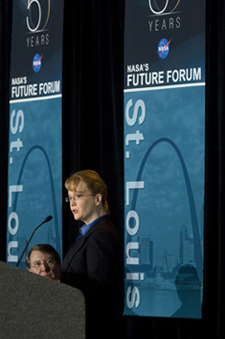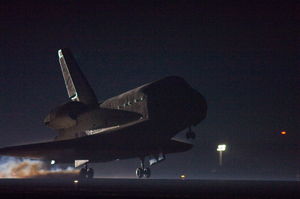International Space Station
This week we launched Space Shuttle Discovery into orbit to conduct one of the most challenging and complex missions on the International Space Station (ISS). Discovery’s crew will install an Italian-built U.S. multi-port module onto the ISS. The node, called Harmony, will allow future Shuttle crews to attach the European and Japanese science laboratories to the ISS so we can increase the size of our science crew. The additional crew and lab space will significantly increase amount of important research we can do on this one-of-a-kind orbiting facility.
When I think about how this mission is going to benefit our ability to do science on the ISS, I also focus on the broader picture of NASA’s overall science portfolio. NASA’s science program is amazing. We study the Earth and we explore the Universe, and everything in between. We land on planets and orbit others. We puzzle over some of the most profound questions of our time: how the did the universe begin and what is its ultimate fate, is the Earth changing, and are we alone. The results of our science missions feed our innate intellectual curiosity, but the innovations required to answer these questions also spark new technologies that help maintain our quality of life and benefit the lives of every person on Earth.
Public Outreach
So, how do we tell the public about our incredible discoveries? I think one of the most powerful tools we have for communicating with people is the amazing images our missions produce, and the visualizations that can be created from the scientific data being returned from our orbiting explorers.
We’ve seen pictures from two landers that have been operating from the surface and craters of Mars since January 2004. We’ve seen stunning up close images of the rings of Saturn and active volcanoes on Jupiter’s moon Io. And, of course, there’s the Hubble Space Telescope which has produced some of the most compelling and enduring images ever taken. The famous picture of the stellar nursery in the Eagle Nebula taken by Hubble is among the most iconic in NASA’s history.
Being understood matters to us at NASA. After all, the value of our work reaches only as far as it contributes to the pursuits of the American ideal, or “the Progress of Science and useful Arts” as the Preamble to the Constitution puts it. That’s why we place so much importance in developing tools to make our work meaningful and clear. NASA operates a fleet of Earth orbiting satellites to collect the information that scientists use to understand our dynamic planet. Each day, these satellites send the data equivalent of the entire Library of Congress to the ground where it is collected, stored and made available to scientists around the world.
While getting the data to the scientists is of course critical, is it equally important that we tell the American taxpayers how we are spending their money and what we are learning from our science programs. Let’s face it. Science is complex, and some of our findings are difficult to explain.
GSFC’s Scientific Visualization Studio
At NASA’s Goddard Space Flight Center, scientists and expert storytellers are teaming up in what Goddard calls its Scientific Visualization Studio to create visualizations of complex scientific processes using actual data . People say a picture is worth a thousand words. So, if we want to be more effective communicating with the public, why not show them what’s going on in the world around them using actual data. That’s where Goddard’s Scientific Visualization Studio can help.
Working together, scientists, computer experts and skilled communicators turn millions and billions of 1’s and 0’s into stunning images that can tell a story. They can show the historical ebb and flow of massive ice sheets at the North and South Poles, pinpoint the location and movement of forest fires like those in California, track the global distribution of dust and pollution, and demonstrate how the abundance of tropical rainfall and the temperature of the oceans provides vital clues for predicting hurricane activity and intensity.
Science on a Sphere
Additionally, Goddard’s Science on a Sphere is an exciting way to communicate science to the public. It provides a unique canvas to view our planet and the universe. The genius of Science on a Sphere is it reminds us neither the Earth, nor much else that we come in contact with every day, is flat. It uses advanced 4-projector, computer controlled technology to present advanced satellite data and other visual effects on a large globe that is suspended on an invisible wire. The first time you see an earth image, or a planet, or other data set projected on the sphere in an otherwise dark room, it takes your breath away. You see the planet the way it actually looks — round, and three dimensional, a complete 360-degree view of whatever is on the screen. Walk around to the other side and you’re suddenly seeing the other side of the world.
The system was developed at NOAA as a means of depicting planetary data sets, like cloud movement, temperature gradations, atmospheric chemistry, and more. Taking the concept one step further, a small but incredibly talented and devoted team from Goddard developed a way to put some of NASA’s most compelling images, animations and visualizations on the Sphere.
On the Sphere we can show the pulse of the planet as satellite sensors measure global chlorophyll concentrations to indicate the distribution and abundance of vegetation which feeds most of the world’s animal life. We can track the evolution of Atlantic hurricanes from their birth off the African coast to their eventual demise over land. We can see what the planet looks like as it crosses from day to night and the city lights turn on. But Earth is not the only star of the show. We can also show planets and their moons as they would look to an orbiting spacecraft, or what the universe looked like in the moments after the Big Bang. The first full-length program created for the Sphere, a movie called “Footprints,” proved so novel and innovative that it was awarded one of Time magazine¹s greatest innovations of 2006.
A Busy Year Ahead
Next year will be one of the busiest for NASA and for Goddard with the launch of the GLAST, the Hubble Servicing Mission, the Lunar Reconnaissance Orbiter (LRO), and the Solar Dynamic Observatory. With its detailed map of the lunar surface, LRO is the first and a most critical step in our plans to move boldly to implement the Vision for Space Exploration. The science delivered by these new and exciting spacecraft, and a practically brand new Hubble, will revolutionize our understanding of the influence the life-giving Sun has on Earth, and unlock many questions about the universe still shrouded in mystery.
But what I really can’t wait for is to see the data returned from these extraordinary missions projected on the Sphere, and finding other ways to share these amazing adventures with the public. It’s going to be an exciting time and through the wonders of technology and innovations like those at Goddard, we’re going to be able to take everybody on the journey with us.
Publ

 On Tuesday, March 25, I spoke at the St. Louis Future Forum which was held in the beautiful St. Louis Science Center. This was the third Future Forum held as part of NASA’s 50th year long anniversary celebration. As I have said in previous blogs, the intent of the Future Forum is to reach out to communities that may not be as knowledgeable about the space program as those of us that live it every day.
On Tuesday, March 25, I spoke at the St. Louis Future Forum which was held in the beautiful St. Louis Science Center. This was the third Future Forum held as part of NASA’s 50th year long anniversary celebration. As I have said in previous blogs, the intent of the Future Forum is to reach out to communities that may not be as knowledgeable about the space program as those of us that live it every day.  Initially, I sat with Mike Griffin on-console in the Launch Control Center (LCC) and listened to the communications between the LCC, Mission Control Center, the Shuttle Training Aircraft and the crew of Endeavour as discussions were held on the weather. The crew was told to do a wave off of the first landing opportunity due to cloud cover in the area. After de-orbit burn, we went to the landing strip to wait.
Initially, I sat with Mike Griffin on-console in the Launch Control Center (LCC) and listened to the communications between the LCC, Mission Control Center, the Shuttle Training Aircraft and the crew of Endeavour as discussions were held on the weather. The crew was told to do a wave off of the first landing opportunity due to cloud cover in the area. After de-orbit burn, we went to the landing strip to wait.  About two minutes before we were able to see the orbiter come into view, there were two sonic booms in quick succession and then Endeavour appeared to glide through the brightness of the xenon lights at the head of the runway. Then once again, she was back on terra firma. This was the 16th night landing at KSC, the 22nd night landing in the Space Shuttle program, and the 68th landing at KSC. Once again, it was an amazing achievement in our human spaceflight program. On March 11, we wished the Endeavour and her crew Godspeed and on March 26, we welcomed her home.
About two minutes before we were able to see the orbiter come into view, there were two sonic booms in quick succession and then Endeavour appeared to glide through the brightness of the xenon lights at the head of the runway. Then once again, she was back on terra firma. This was the 16th night landing at KSC, the 22nd night landing in the Space Shuttle program, and the 68th landing at KSC. Once again, it was an amazing achievement in our human spaceflight program. On March 11, we wished the Endeavour and her crew Godspeed and on March 26, we welcomed her home.